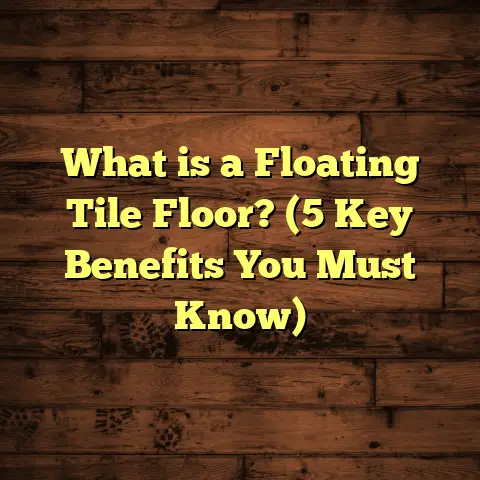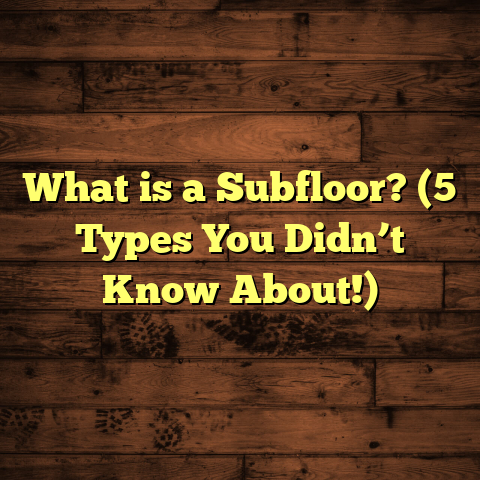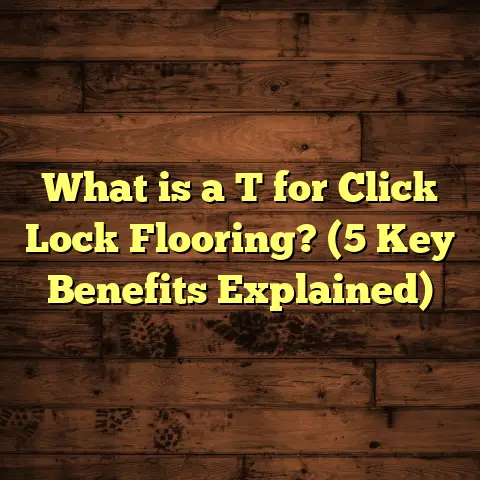What is a Polycarbonate Floor Mat vs PVC? (5 Key Differences Explained)
When I first got into flooring work, I was always surprised at how many types of floor mats were out there—especially the differences between polycarbonate and PVC mats. If you’re like me, you want to get the most value for your money without sacrificing quality or durability. So, I’ll start by talking about cost-effectiveness, because that’s what most people ask about first.
Why Cost-Effectiveness Matters: My Take on Flooring Mats
Over the years, I’ve seen clients make decisions based purely on price. They’ll pick the cheapest mat and then come back frustrated because it wore out too quickly or didn’t stand up to daily use. On the flip side, some go for the most expensive option without knowing if they really need it, which can be a waste.
Getting cost-effectiveness right means understanding not just the initial price but how long the mat will last and how well it suits your space. A cheap mat that lasts a year isn’t as cost-effective as a pricier one that lasts five years.
That’s why when I compare polycarbonate and PVC mats, I always focus on total value—durability, comfort, maintenance, and appearance—all tied back to cost over time.
What Is a Polycarbonate Floor Mat vs PVC?
Let’s start with clear definitions. It’s easy to confuse these materials if you don’t know what they really are.
Polycarbonate Floor Mats Explained
Polycarbonate is a type of plastic known for its incredible strength and clarity. It started as a material used in eyewear lenses and bulletproof glass because it’s tough but still transparent.
In flooring mats, polycarbonate means you get a product that’s resistant to cracking, impact, and even temperature changes. The mats are typically rigid but lightweight.
What surprised me when I first worked with polycarbonate mats was how well they held up in harsh environments. One client had a factory where forklifts moved heavy pallets around daily. Instead of getting gouged or cracked mats, polycarbonate held strong for years.
Polycarbonate mats often have smooth or textured surfaces and can be transparent or tinted. This feature is great if you want to showcase the floor beneath or maintain a modern look.
PVC Floor Mats Explained
PVC (polyvinyl chloride) is another common plastic used in a huge range of products—from pipes to clothing to flooring.
Unlike polycarbonate, PVC is softer and more flexible. It can be made into mats that feel cushioned underfoot and can bend without breaking.
PVC mats are popular in places requiring comfort and chemical resistance—like hospitals, gyms, kitchens, and playgrounds. They resist water and many cleaning agents, making them low-maintenance.
What I like about PVC is how forgiving it is underfoot. When I installed PVC mats in a daycare center, the staff told me kids could play all day without worrying about hard falls.
5 Key Differences Between Polycarbonate and PVC Floor Mats
Having installed both types in dozens of projects, I found five major ways these materials differ. Let’s unpack each one with details from my experience plus some data to back it up.
1. Durability and Impact Resistance
Polycarbonate mats are incredibly durable. Their impact resistance is among the highest for plastics used in flooring. To put numbers on it: polycarbonate’s impact resistance is roughly 10 times greater than typical PVC compounds used in mats.
In practical terms, when a heavy tool or piece of equipment drops on a polycarbonate mat, it usually doesn’t crack or dent. I’ve seen industrial clients with forklifts drive over these mats repeatedly without damage.
PVC mats handle impacts well but tend to scratch or dent with sharp objects or heavy loads. I once saw PVC mats in a car garage start to peel after just a few months because they weren’t designed for that level of abuse.
If you expect heavy traffic or rough use, polycarbonate will save you replacement costs down the line.
2. Cost-Effectiveness Over Time
PVC mats typically cost less upfront—often 20-40% cheaper than polycarbonate options. For example:
- PVC mat price range: $2 – $5 per sq. ft.
- Polycarbonate mat price range: $4 – $7 per sq. ft.
These prices depend on thickness, design, and supplier.
However, what matters is lifespan. Industry reports show:
- Polycarbonate floor mats last 5-7 years under moderate-heavy use.
- PVC mats last 2-4 years under similar conditions.
That means even though polycarbonate costs more initially, you might spend less overall if you factor in how often you replace the mats.
I had a client who chose PVC mats for his workshop to save money initially but ended up replacing them twice in five years. When he switched to polycarbonate mats after that, he didn’t need replacements for over six years—a clear win for value.
3. Flexibility and Comfort Underfoot
PVC mats are softer and more flexible than polycarbonate mats. This makes them better choices where people stand for long periods—like in kitchens or retail stores.
I once installed PVC mats in a restaurant kitchen where chefs spend hours on their feet daily. The cushioned surface reduced fatigue and even helped reduce complaints about sore feet from staff.
Polycarbonate mats feel firmer underfoot with little give. They’re not uncomfortable but won’t provide cushioning benefits like PVC does. Instead, their strength and rigidity make them easier to clean and maintain since dirt doesn’t embed as easily in flexible surfaces.
4. Chemical and UV Resistance
Both materials resist chemicals well but differ slightly in what they tolerate best.
PVC is known for excellent resistance to oils, solvents, acids, and cleaning products—making it suitable for labs, hospitals, and food prep areas.
Polycarbonate also resists many chemicals but can degrade if exposed to sunlight (UV rays) over time unless specially treated with UV stabilizers.
For outdoor use where sun exposure is constant, untreated polycarbonate mats may yellow or become brittle after extended periods. PVC usually performs better outdoors because it can be formulated with UV inhibitors more easily.
5. Appearance and Design Options
Polycarbonate mats often have a clearer or glossy finish compared to PVC mats. You can get transparent versions that protect the floor while showing it off underneath—a style choice some customers really appreciate.
PVC mats come in many colors and textures but rarely match the same level of clarity or shine as polycarbonate. They’re usually matte or semi-glossy.
If aesthetics matter in your home or office space, polycarbonate offers more modern options. For purely functional spaces like garages or gyms, PVC’s color variety works well enough.
Diving Deeper: Technical Properties Breakdown
Let me share some technical details I’ve gathered over years of working with manufacturers and suppliers:
| Property | Polycarbonate | PVC |
|---|---|---|
| Tensile Strength | ~60-70 MPa | ~40-50 MPa |
| Impact Resistance | Very High (Notched Izod ~600 J/m) | Moderate (Notched Izod ~150-200 J/m) |
| Flexibility | Low (Rigid) | High (Flexible) |
| UV Resistance | Moderate (Needs treatment) | High (with stabilizers) |
| Chemical Resistance | Moderate | High |
| Cost per square foot | $4-$7 | $2-$5 |
| Typical Lifespan | 5-7 years | 2-4 years |
| Water Absorption | Very low | Low |
These numbers explain why polycarbonate is sturdier but less flexible than PVC.
Real-World Case Studies From My Projects
Case Study 1: Industrial Workshop Flooring
Client: A metal fabrication shop with heavy machinery and forklift traffic.
Challenge: Floor mats needed to withstand dropped tools, oil spills, and constant heavy weight.
Solution: We installed thick polycarbonate floor mats with textured surfaces for slip resistance.
Outcome: The mats lasted over six years with minimal wear or damage. The client saved money by avoiding frequent replacements typical with cheaper PVC alternatives they had tried before.
Case Study 2: Daycare Play Area
Client: A daycare center needing safe flooring for children’s playroom.
Challenge: The floor needed cushioning to protect kids from falls while being easy to clean.
Solution: We installed soft PVC mats in bright colors with non-toxic finishes.
Outcome: Staff reported fewer injuries from slips/falls and praised ease of cleaning spills daily. The client replaced the mats after three years due to wear but appreciated the affordable price point.
Case Study 3: Outdoor Patio Covering
Client: Homeowner wanted durable outdoor patio floor protection against weather and UV exposure.
Challenge: Mats needed to resist sun damage and moisture without fading or becoming brittle.
Solution: We used UV-stabilized PVC floor mats designed for outdoor use.
Outcome: After four summers of sun exposure, the mats maintained flexibility and color better than several polycarbonate samples tested onsite that showed yellowing signs after two seasons without UV treatment.
Maintenance Tips Based on My Experience
Keeping your floor mats in top shape depends on material:
- Polycarbonate Mats: Clean frequently with mild detergent; avoid abrasive cleaners that may scratch glossy surfaces. Watch for UV exposure; consider shaded placement or UV coatings outdoors.
- PVC Mats: Wipe down regularly; resist stains well but avoid harsh solvents that can degrade softer plastics. For outdoor use, check periodically for brittleness due to weathering.
In both cases, removing debris prevents wear spots and extends lifespan significantly.
Comparing Polycarbonate & PVC Mats With Other Flooring Solutions
If you’re curious how these two materials stand up against other popular flooring options:
Rubber Mats
Rubber offers excellent cushioning and natural slip resistance but tends to cost more than PVC and polycarbonate mats combined. It can also degrade faster in oily environments or with exposure to some chemicals.
I’ve used rubber mats in gym settings where cushioning is key but switched to polycarbonate in industrial zones where toughness matters more than softness.
Vinyl Flooring
Vinyl sheets or tiles are popular for their aesthetics and moisture resistance but generally don’t offer the same durability as polycarbonate or chemical resistance as PVC mats designed specifically for floors.
For high-impact areas or heavy traffic zones, I recommend sticking with polycarbonate or PVC instead of vinyl alone.
Carpet Mats
Carpeted floor mats provide warmth and noise reduction but are tough to maintain in wet or dirty conditions. They absorb liquids easily which can lead to mold or odors.
If you want easy cleaning plus durability, polycarbonate or PVC are better choices depending on flexibility needs.
Final Thoughts From My Flooring Journey
Choosing between polycarbonate and PVC floor mats comes down to matching material properties with your specific needs:
- Need long-lasting durability with impact resistance? Go polycarbonate.
- Want comfortable cushioning with good chemical resistance on a budget? Pick PVC.
- Outdoor space? Consider UV-stabilized versions of either.
- Want clear design options? Polycarbonate offers sleek looks.
- Need soft feel? PVC wins there hands-down.
I hope sharing my hands-on experience combined with technical data helps you make an informed choice without regrets later on.
If you want help estimating costs or figuring out material quantities tailored to your project size and location, tools like FloorTally have saved me lots of time by providing detailed cost breakdowns including waste factors and labor estimates based on local rates.
Don’t rush this decision—think about traffic type, expected lifespan, maintenance willingness, budget limits—and pick what makes sense for you today—and down the road after years of use!
Have questions about installation techniques? Care tips? Or want me to break down cost comparisons on your specific project? Just ask—I’m happy to help!





